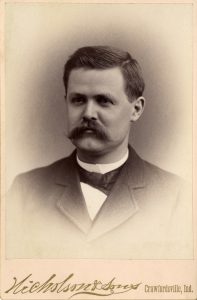https://www.wabash.edu/academics/profiles/home.cfm?site_folder=biology&vdeptid=3&facname=ingrama
John Merle Coulter was the Rose Professor of Geology and Natural History at Wabash College from 1879-91, bringing an advanced view of the sciences to the College. He was also influential in the scientific study of what would become Yellowstone National Park.
Coulter was one of two botanists on the 1871 Hayden Expedition, the first scientific expedition in the area. The Hayden group brought back scientific corroboration of thermal activity and gave the world an improved map of Yellowstone and visual proof of the area’s unique landscape.
He brought his impressive collection of herbarium specimens – preserved plant samples for long-term study – with him when he took the position at Wabash, ultimately building what was one of the largest herbaria in the United States in the 1890s.
Very popular on campus, Coulter lobbied for better storage for the collections of the science department including an herbarium

and many geological specimens. These efforts led to the transformation of the old gymnasium into the Hovey Museum. Coulter left Wabash in 1891 to become president of Indiana University.
Coulter’s botanical legacy is substantial. He and his brother, Stanley Coulter, founded The Botanical Gazette in 1875, a long-lived periodical featuring papers on a range of botanical topics, which he edited until 1926. He served as head of the Department of Botany at the University of Chicago for nearly 30 years and gained a reputation as one of the leading plant taxonomists of the early 20th century.
He published an early checklist of Indiana’s plants, as well as monographs on plant groups ranging from cacti to pines. He was twice elected President of the Botanical Society of America, which he helped found. He trained numerous students while at University of Chicago, and his botanical legacy is linked directly to current College botanist Amanda Ingram, his academic great-great-great-great-grandchild through five generations of Ph.D. advisors and mentors.
“To this day, fellow botanists get excited when they see that I work at one of the institutions that supported Coulter early in his career,” Ingram noted. “People who care about the history of our field know that he played an important role as a scientist, mentor, and leader.”
The Wabash legacy that sprung from Coulter’s work in botany continues today in our biology department through names like Mason Thomas (1891-1912), Albert Bechtel (1920-52), Richard Laubengayer (1946-64), Robert Petty (1959-90), Tom Cole (1962-98), Aus Brooks (1966-2004), Bill Doemel (1970-2011), David Krohne (1979-2012), and Ingram (2004-present).
The Wabash connections to Yellowstone National Park continue as well. Krohne and Doemel did research there, while Doemel and Brooks led aquatic biology students to the park, among other locations.